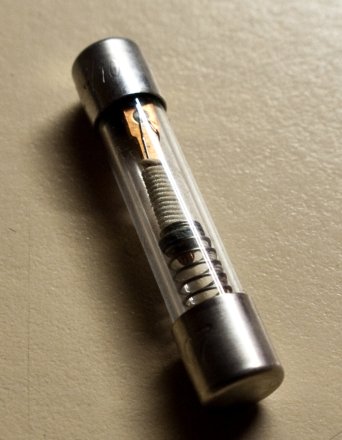
Various types of fuses are available, classified on the basis of their parameters. Largely they are classified as DC and AC fuse on the basis of input supply voltages. In a control panel mainly AC fuses are used
DC fuse operates on DC power supply. The amplitude of DC remains constant. The only difficulty with a DC fuse is that the arc produced by the direct current is difficult to compensate, as the DC voltage remains constant. This constant voltage produces a high arc between the electrodes of the fuse. To reduce the DC fuse arcing, the electrodes are placed further apart, due to which the size of a DC fuse is bigger as compared to an AC fuse
An AC fuse operates on AC power supply. The amplitude of AC supply varies instantaneously. In India, the rate of change of AC supply is 50 cycles per second. It means that an AC signal will have 50 positive half and 50 negative half in one second. This rate of change is called frequency of AC signal. Thus, the arc produced in an AC fuse can be easily compensated as compared to the arc in a DC circuit. An AC fuse is classified further into low voltage fuse and high voltage fuse
Low voltage fuse can be further divided into four classes: rewirable fuse, cartridge fuse, dropout fuse and striker fuse.Rewirable fuse is a commonly used fuse in house wiring. The fuse wire can be changed if the wire is blown off due to excess heating or current flow. It is also known as a kitkat fuse
Fuses are used in motors and transformers, home distribution boards, general electrical appliances and devices, laptops, cell phones, gaming systems, printers, digital cameras, DVD players, portable electronics, LCD monitors, scanners, battery packs, hard disk drives and power converters.
cartridge type or totally enclosed fuse, the fuse element is fit into an enclosed container. It has metal contacts on both sides. A cartridge fuse is further classified into a D-type cartridge fuse and a link type cartridge fuse
The main parts of a D-type cartridge fuse are the base, adapter ring, cartridge and a fuse cap
link type cartridge or high rupturing capacity (HRC) fuse, the fuse element carries fault current for a longer duration. If the fault is not clear, then the fuse element will melt and open the circuit. HRC fuse has high-speed operation and does not require maintenance, but, the fuse element needs to be rplaced after each operation. The enclosure of the HRC fuse is filled with powdered pure quartz, which acts as a heat absorbing material. Silver and copper wire is used to make the fuse wire
dropout fuse is that in which the melting of the fuse causes the fuse element to drop in the lower portion of the fuse. This type of fuse is used for the protection of outdoor transformers. High Voltage HRC Fuse This type of fuse deals with high voltage. While operating with high voltage, the corona effect may occur. Therefore, high voltage fuses are specially designed to overcome the corona effect. HRC fuses are mainly classified into three types – cartridge type high voltage HRC fuses, expulsion type high voltage fuses and liquid type HRC fuses.
In a cartridge type high voltage HRC fuse the fuse element is wound in the shape of a helix, which avoids the corona effect at higher voltages. It has two fused elements placed parallel to each other, one of low resistance and the other of high resistance. The low resistance wire carries normal current, which is blown out, thereby reducing the short circuit current during a fault condition. Corona effect in an electrical system means “the glow around a conductor at high potential” or a cloud of charge around a high voltage transmission wire.
Liquid type high voltage HRC fuse is filled with carbon tetra-chloride and sealed at both ends. When a fault occurs the current exceeds beyond the permissible limit and blows out the fuse element. The liquid of the fuse acts as an arc extinguishing medium for the HRC fuse. Expulsion type high voltage fuse is a vented fuse in which the expulsion effect of the gases produced by internal arcing, either alone or aided by other mechanisms, results in current interruption. Expulsion type fuses are widely used for the protection of feeders and transformers because of their low cost
Striker fuse- Striker fuse is also known as a pin fuse. When the fuse blows, a pin ejects from one end in such a way that the fuse cannot be reinstalled This ejected pin indicates that the fuse has blown. It is a mechanical device with enough force and displacement to trip circuits.